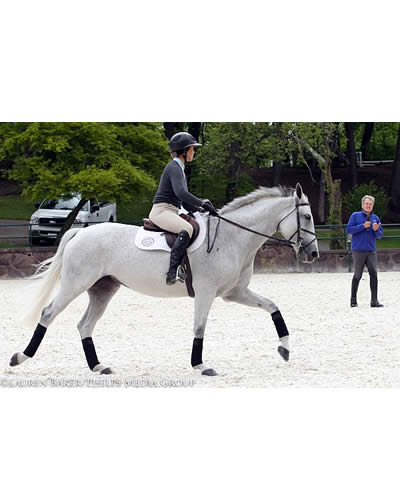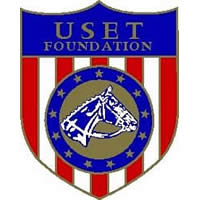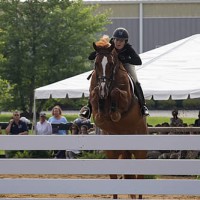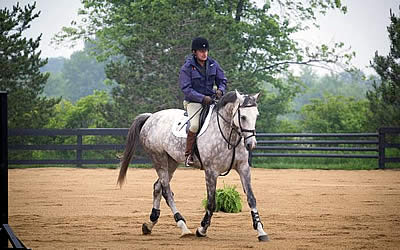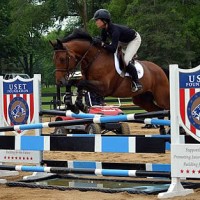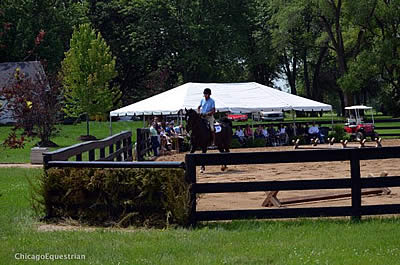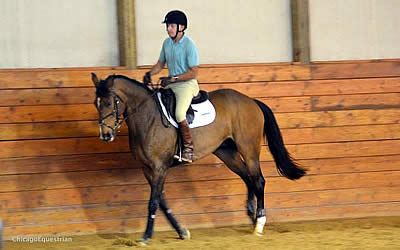Dr. Gerd Heuschmann works with Sophie Verges.
Gladstone, NJ – May 20, 2015 – As the sun rose over Hamilton Farm on day two of the USET Foundation’s Gladstone Program, George H. Morris zipped his Ariat Team USA jacket all the way up. “It’s a bit cold,” Morris remarked as he assumed the driver’s seat in his signature golf cart, stepping on the gas to meet the first group of riders in the outdoor arena.
Katie Cox, Lisa Goldman, Sean Leckie and Kilian McGrath rode into the large arena at 8 a.m., ready to begin another day of flat work with Morris and German veterinarian Dr. Gerd Heuschmann.
The ring was set up with one ground pole on each side and two separate combinations of cavaletti in the center. One combination had three elements, which could only be taken at the trot. The other had two cavaletti, which could be ridden at the trot or canter.
After walking the horses, Heuschmann instructed the riders to pick up a very slow trot, working on relaxing deep into the saddle and waiting for the horse to initiate contact, keeping a steady inside-leg pressure all the while.
“When you warm up, you connect to your horse,” Heuschmann explained. “Your horse has to learn to wait for your seat. If you don’t have the back, you don’t have the horse. You can only drive if the horse waits for you.”
Heuschmann continued by teaching the riders to raise their inside hands slightly to encourage their mounts to round at the poll, keeping constant pressure on the outside rein and waiting for the steady inside leg to encourage the horse to sink into a longer frame.
As the horses showed signs of accepting the seat and relaxing, Heuschmann told the riders to open the stride when they felt the horses with them.
After moving through walk-trot transitions and opening up to various strides at the trot, the riders moved to the canter, lengthening and shortening the strides to stretch and flex the horse’s topline.
Katie Cox’s horse, Twilight, looked noticeably more relaxed today, collecting nicely and quietly transitioning between gaits.
Heuschmann remarked, “This horse is doing much better today, George,” to which Morris responded with a drawn-out ‘yay’ as he cantered by on BB Casablanca.
After slowly working the grey mare through circles and transitions at a slow, collected pace, the satisfied Morris hopped off, making way for rider Kilian McGrath.
Once Morris assumed command of the microphone, the riders began working over the cavaletti, tracking left to make a figure eight over both sets. Morris explained that cavaletti work is crucial to bridge the gap between flat work and jumping.
“You people need steady contact,” Morris reminded the riders. “If the horse resists the bit, close your hand; don’t saw on his mouth.”

Under Morris’ direction, the riders got into jumping half seat and began lengthening the canter stride around the ring, preparing themselves for the week of jumping ahead. Morris was adamant about being able to ride from all seats, changing the hip angle to match the task at hand.
“Constipated cats,” Morris boomed over the microphone, warning the riders about getting too stiff. “I don’t want constipated cats like we had in Wellington.”
As the horses began to break into a sweat, Morris announced that they had enough and needed to rest in order to jump the rest of the week.
With that, group one filed out of the ring and group two started tacking up their horses in the barn.
At 10 a.m. sharp, Haley Gassel, Taylor Harris, Sophie Verges and Kate Mulligan entered the arena and began a similar program as the first group, working on initiating connection with their seats.
“You have to feel as if you weigh an extra 200 pounds,” Heuschmann said. “Smile and relax as if you had a whiskey.”
Heuschmann took 20 minutes to warm up Gassel’s Quiet Dark 2, doing transitions and circles while rounding the “big guy” at the poll and encouraging him to engage his hind end.
On the opposite end of the arena, Harris received some one-on-one attention from Morris, who worked with her on an invisible lunge line to calmly warm up her spooky horse.
Morris instructed Harris to lengthen and shorten the stride, throwing in the occasional shoulder-in, half pass and change of direction. Eventually, the pair was cantering, counter cantering and changing leads quietly.
The young riders finished warming up under Heuschmann’s expert eye, working on steady rein contact combined with driving and bending laterally from the seat and legs to collect the horses with forward impulsion.
When Morris came back to the microphone, there was not a second of hesitation as he asked the riders to make figure eights over the cavaletti, lengthening and shortening their strides, maintaining contact and impulsion throughout the exercise.
“The horse is active, but does not rush contact,” Morris explained. “The horse has to listen, not run through the hand.”
When Morris was satisfied with everyone, he simply stated, “very good,” marking the end of the day’s lesson for group two.
Dr. Gerd Heuschmann will be returning to Germany and wanted to leave the riders and spectators with a final word of advice: “Classical riding only works if you love your horse and you love to ride.”
The Gladstone Program will continue Thursday morning with over-fences sessions at 8 a.m. and 10 a.m., and media training with Mason Phelps, Chip McKinney and Ariel Weisman of Phelps Media Group at 1:30 p.m. Riding sessions are open to the public for auditing.
The United States Equestrian Team Foundation (www.uset.org) is the non-profit organization that supports the competition, training, coaching, travel and educational needs of America’s elite and developing international, high-performance horses and athletes in partnership with the United States Equestrian Federation.
For more information on the USET Foundation, please call (908) 234-1251, or visit USET ONLINE at www.uset.org.
The USET Foundation has been awarded Charity Navigators’ highest honor, a Four Star rating for good governance, sound fiscal management and commitment to accountability and transparency.
Contact: Rebecca Walton
USET Foundation
phone 561.753.3389 fax 561.753.3386
rjw@phelpsmediagroup.com
PhelpsMediaGroup.com
